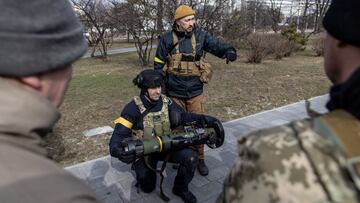What is an anti-tank missile?
The US and its allies have rushed to supply the Ukrainian military with weapons to repel the Russian invasion including sophisticated anti-tank weapons.

Tanks rolling across fields and through cities, as is happening in Ukraine, is a terrifying sight. The massive, heavily armored vehicles seem like they are invincible. However, the Ukrainian forces have been able to stimmy and slow the advance of the overwhelming invading force bearing down on the capital Kyiv.
This is due in part to their successful use of thousands of anti-tank weapons hurriedly sent to them prior to and in the early days of the invasion. Among those weapons are missiles specifically designed to counter a tank’s defenses. Here’s a look at how they work.
Also see:
- What is an anti-radiation missile?
- Ukraine has been attacked by more than 600 Russian missiles
- Russian juggernaut stalled en route to Kyiv
- Russian's strategy behind capturing Ukrainian nuclear assets
Weapons that are effective against tanks
At the start of the Russian invasion the Ukrainian government, besides handing out weapons to the public, gave instructions on how to make Molotov cocktails. These have been used against tanks since the Spanish Civil War. Although they can’t harm modern tanks, they can blind sensors on them and can have a powerful psychological impact on the operators inside.
A tank’s ability to cross diverse terrain carrying powerful weapons mounted on them while protecting the crew inside make them formidable weapons. But the two tracks they ride upon can be their Achilles heel. Should they be damaged or be made inoperable the tank can no longer maneuver and it becomes a sitting duck for a counterattack.
Landmines, grenades and other explosives thrown or launched into them can break or dislodge them but something far less lethal can stop them in their tracks, mud. There was speculation that Putin and his military leaders were waiting to give the order to invade when the ground in Ukraine was frozen solid. This usually happens in late January through February in Ukraine.
Video, possible from the range in Rostov region. Digger helping tanks stuck in the mud pic.twitter.com/jGFTL5puki via @4emberlen
— Liveuamap (@Liveuamap) February 10, 2022
However, this winter was mild and the ground was extremely muddy in parts of Ukraine and will become more so as spring sets in. Pictures of Russian tanks and other heavy vehicles abandoned, stuck in mud have been all over social media since the beginning of the invasion.
But the most lethal weapon are anti-tank missiles.
Types of anti-tank missiles
Anti-tank missile technology has advanced greatly over the years in response to new protective measures as well as to kept those attacking tanks out of harm’s way. There are a range of missiles employed around the world that can be fired from tripods, vehicles, aircraft or by an individual soldier.
The Javelin weapon system, which has been supplied to Ukraine, is considered one of the best shoulder-fired anti-tank weapons. It can also be mounted on light armoured vehicles, trucks, and remotely piloted vehicles or fired from tripods.
Related stories
It carries a tandem shaped charge which is an explosive devices that has two or more stages of detonation that is effective at defeating reactive armor designed to protect a tank against anti-tank munitions. The Javelin has a maximum range of 2,500 meters or just over a mile and a half.
Before firing the gunner locks the missile onto a target with a fire-and-forget system so that they can take cover after the weapon is launched. The missile climbs above its target using a long-wave infrared seeker and then hits the top of the tank where it is the weakest.


